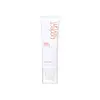What's inside
What's inside
 Key Ingredients
Key Ingredients

 Benefits
Benefits

 Concerns
Concerns

 Ingredients Side-by-side
Ingredients Side-by-side

Water
Skin ConditioningPropylene Glycol
HumectantDimethicone
EmollientMyristyl Alcohol
EmollientButylene Glycol
HumectantGlycerin
HumectantDiphenylsiloxy Phenyl Trimethicone
Skin ConditioningAminopropyl Dimethicone
Alcohol Denat.
AntimicrobialEthylhexylglycerin
Skin ConditioningGamma-Docosalactone
Skin ConditioningSteartrimonium Chloride
PreservativeCetearyl Alcohol
EmollientCaprylic/Capric Triglyceride
MaskingHydroxyethylcellulose
Emulsion StabilisingPhenoxyethanol
PreservativeBehentrimonium Chloride
PreservativePrunus Persica Kernel Oil
EmollientPrunus Persica Fruit Extract
AbrasiveDisodium EDTA
Parfum
MaskingWater, Propylene Glycol, Dimethicone, Myristyl Alcohol, Butylene Glycol, Glycerin, Diphenylsiloxy Phenyl Trimethicone, Aminopropyl Dimethicone, Alcohol Denat., Ethylhexylglycerin, Gamma-Docosalactone, Steartrimonium Chloride, Cetearyl Alcohol, Caprylic/Capric Triglyceride, Hydroxyethylcellulose, Phenoxyethanol, Behentrimonium Chloride, Prunus Persica Kernel Oil, Prunus Persica Fruit Extract, Disodium EDTA, Parfum
Water
Skin ConditioningDipropylene Glycol
HumectantDicaprylyl Carbonate
EmollientDimethicone
EmollientCetyl Alcohol
EmollientStearamidopropyl Dimethylamine
EmulsifyingDipentaerythrityl Hexahydroxystearate/Hexastearate/Hexarosinate
Skin ConditioningAmodimethicone
Parfum
MaskingLactic Acid
BufferingBis-PEG-18 Methyl Ether Dimethyl Silane
EmollientGuar Hydroxypropyltrimonium Chloride
Skin ConditioningTrideceth-10
CleansingEthylhexylglycerin
Skin Conditioning1,2-Hexanediol
Skin ConditioningLimonene
PerfumingLinalool
PerfumingCitronellol
PerfumingGeraniol
PerfumingTocopherol
AntioxidantArgania Spinosa Kernel Oil
EmollientPrunus Armeniaca Kernel Oil
MaskingOlea Europaea Fruit Oil
MaskingSimmondsia Chinensis Seed Oil
EmollientCamellia Japonica Seed Oil
EmollientCocos Nucifera Oil
MaskingCI 15985
Cosmetic ColorantCoco-Caprylate/Caprate
EmollientSclerocarya Birrea Seed Oil
HumectantAcid Red 33
Glycolipids
Skin ConditioningWater, Dipropylene Glycol, Dicaprylyl Carbonate, Dimethicone, Cetyl Alcohol, Stearamidopropyl Dimethylamine, Dipentaerythrityl Hexahydroxystearate/Hexastearate/Hexarosinate, Amodimethicone, Parfum, Lactic Acid, Bis-PEG-18 Methyl Ether Dimethyl Silane, Guar Hydroxypropyltrimonium Chloride, Trideceth-10, Ethylhexylglycerin, 1,2-Hexanediol, Limonene, Linalool, Citronellol, Geraniol, Tocopherol, Argania Spinosa Kernel Oil, Prunus Armeniaca Kernel Oil, Olea Europaea Fruit Oil, Simmondsia Chinensis Seed Oil, Camellia Japonica Seed Oil, Cocos Nucifera Oil, CI 15985, Coco-Caprylate/Caprate, Sclerocarya Birrea Seed Oil, Acid Red 33, Glycolipids
Ingredients Explained
These ingredients are found in both products.
Ingredients higher up in an ingredient list are typically present in a larger amount.
Dimethicone is a type of synthetic silicone created from natural materials such as quartz.
What it does:
Dimethicone comes in different viscosities:
Depending on the viscosity, dimethicone has different properties.
Ingredients lists don't always show which type is used, so we recommend reaching out to the brand if you have questions about the viscosity.
This ingredient is unlikely to cause irritation because it does not get absorbed into skin. However, people with silicone allergies should be careful about using this ingredient.
Note: Dimethicone may contribute to pilling. This is because it is not oil or water soluble, so pilling may occur when layered with products. When mixed with heavy oils in a formula, the outcome is also quite greasy.
Learn more about DimethiconeEthylhexylglycerin (we can't pronounce this either) is commonly used as a preservative and skin softener. It is derived from glyceryl.
You might see Ethylhexylglycerin often paired with other preservatives such as phenoxyethanol. Ethylhexylglycerin has been found to increase the effectiveness of these other preservatives.
Parfum is a catch-all term for an ingredient or more that is used to give a scent to products.
Also called "fragrance", this ingredient can be a blend of hundreds of chemicals or plant oils. This means every product with "fragrance" or "parfum" in the ingredients list is a different mixture.
For instance, Habanolide is a proprietary trade name for a specific aroma chemical. When used as a fragrance ingredient in cosmetics, most aroma chemicals fall under the broad labeling category of “FRAGRANCE” or “PARFUM” according to EU and US regulations.
The term 'parfum' or 'fragrance' is not regulated in many countries. In many cases, it is up to the brand to define this term.
For instance, many brands choose to label themselves as "fragrance-free" because they are not using synthetic fragrances. However, their products may still contain ingredients such as essential oils that are considered a fragrance by INCI standards.
One example is Calendula flower extract. Calendula is an essential oil that still imparts a scent or 'fragrance'.
Depending on the blend, the ingredients in the mixture can cause allergies and sensitivities on the skin. Some ingredients that are known EU allergens include linalool and citronellol.
Parfum can also be used to mask or cover an unpleasant scent.
The bottom line is: not all fragrances/parfum/ingredients are created equally. If you are worried about fragrances, we recommend taking a closer look at an ingredient. And of course, we always recommend speaking with a professional.
Learn more about ParfumWater. It's the most common cosmetic ingredient of all. You'll usually see it at the top of ingredient lists, meaning that it makes up the largest part of the product.
So why is it so popular? Water most often acts as a solvent - this means that it helps dissolve other ingredients into the formulation.
You'll also recognize water as that liquid we all need to stay alive. If you see this, drink a glass of water. Stay hydrated!
Learn more about Water